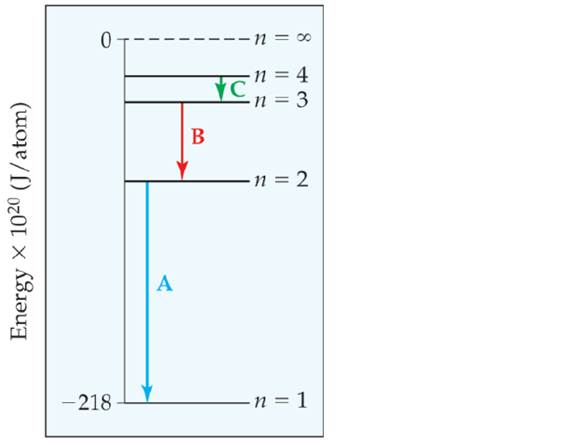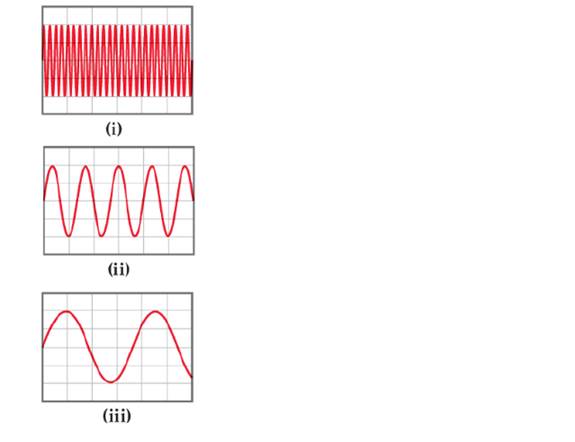
CHEMISTRY:CENTRAL SCIENCE-W/MOD.ACCESS
14th Edition
ISBN: 9780134809694
Author: Brown
Publisher: PEARSON
expand_more
expand_more
format_list_bulleted
Concept explainers
Textbook Question
Chapter 6, Problem 7E
Consider the three electronic transitions in a hydrogen atom shown here, labeled A, B, and C.
- Three
electromagnetic waves, all drawn on the same scale, are also shown. Each corresponds to one of the transitions. Which electromagnetic wave (i), (ii), or (iii), is associated with electronic transition C?


Expert Solution & Answer
Want to see the full answer?
Check out a sample textbook solution
Students have asked these similar questions
None
None
None
Chapter 6 Solutions
CHEMISTRY:CENTRAL SCIENCE-W/MOD.ACCESS
Ch. 6.1 - A source of electromagnetic radiation produces...Ch. 6.1 - Which type of visible light has a longer...Ch. 6.1 - Consider the following three statements: For any...Ch. 6.1 - A laser used in orthopedic spine surgery produces...Ch. 6.2 - Prob. 6.3.1PECh. 6.2 -
A laser emits light that has a frequency of 4.69...Ch. 6.3 - Prob. 6.4.1PECh. 6.3 -
For each of the following transitions, give the...Ch. 6.4 - Consider the following three moving objects: a...Ch. 6.4 - Calculate the velocity of a neutron whose de...
Ch. 6.5 - An orbital has n = 4 and ml = 0, 1, 2, 3 -3, - 2,...Ch. 6.5 -
What is the designation for the subshell with = 5...Ch. 6.8 - How many of the elements in the second row of the...Ch. 6.8 - Write the electron configuration for silicon,...Ch. 6.9 - A certain atom has an ns2np2electron configuration...Ch. 6.9 -
Which group of elements is characterized by an...Ch. 6.9 -
A certain atom has a [noble gas]5s24d105p4...Ch. 6.9 - Prob. 6.9.2PECh. 6 - In this chapter, we have learned about the...Ch. 6 - The speed of sound in dry air at 20°C is 343 m/s...Ch. 6 -
6.2 A popular kitchen appliance produces...Ch. 6 - 6.3 The following diagrams represent two...Ch. 6 -
6.4 Stars do not all have the same temperature....Ch. 6 - 6 5 The familiar phenomenon of a rainbow results...Ch. 6 -
6.7 A certain quantum mechanical system has the...Ch. 6 - Consider the three electronic transitions in a...Ch. 6 - Prob. 8ECh. 6 -
6.9 The contour representation of one of the...Ch. 6 -
6.10 The accompanying drawing shows a contour...Ch. 6 -
8.11 Four possible electron configurations for a...Ch. 6 -
6.12 State where in the periodic table these...Ch. 6 - Prob. 13ECh. 6 -
6.14
a What is the relationship between the...Ch. 6 - Label each of the following statements as true or...Ch. 6 - Determine which of the following statements are...Ch. 6 - Arrange the following kinds of electromagnetic...Ch. 6 - List the following types of electromagnetic...Ch. 6 - What is the frequency of radiation that has a...Ch. 6 - What is the frequency of radiation whose...Ch. 6 - A laser pointer used in a lecture hall emits light...Ch. 6 - It is possible to convert radiant energy into...Ch. 6 - If human height were quantized in 1-foot...Ch. 6 - Einstein's 1905 paper on the photoelectric effect...Ch. 6 - Calculate the energy of a photon of...Ch. 6 - Prob. 26ECh. 6 - Prob. 27ECh. 6 - An AM radio station broadcasts at 1010 kHz, and...Ch. 6 - One type of sunburn occurs on exposure to UV light...Ch. 6 - Prob. 30ECh. 6 - Prob. 31ECh. 6 - A stellar object is emitting radiation at 3.55 mm....Ch. 6 - Molybdenum metal must absorb radiation with a...Ch. 6 - Titanium metal requires a photon with a minimum...Ch. 6 - Prob. 35ECh. 6 - Classify each of the following statements as...Ch. 6 - Prob. 37ECh. 6 -
6 38 Indicate whether energy is emitted or...Ch. 6 - Using Equation 6.5. calculate the energy of an...Ch. 6 - Prob. 40ECh. 6 - The visible emission lines observed by Balmer all...Ch. 6 - Prob. 42ECh. 6 - Prob. 43ECh. 6 - The hydrogen atom can absorb light of wavelength...Ch. 6 - Prob. 45ECh. 6 - Prob. 46ECh. 6 - Use the de Brogue relationship to determine the...Ch. 6 - Prob. 48ECh. 6 - Neutron diffraction is an important technique for...Ch. 6 - The electron microscope has been widely used to...Ch. 6 - Using Heisenberg's uncertainty principle,...Ch. 6 - Prob. 52ECh. 6 - Classify the following statements as either true...Ch. 6 - 0 1 2 3 4 5 6 7 8 9 10 Distance from the nucleus,...Ch. 6 - Prob. 55ECh. 6 - Prob. 56ECh. 6 - Prob. 57ECh. 6 - Give the values for n, I,and mlfor each orbital in...Ch. 6 - Prob. 59ECh. 6 - Prob. 60ECh. 6 - Which of the following represent impossible...Ch. 6 - For the table that follows, write which orbital...Ch. 6 - Sketch the shape and orientation of the following...Ch. 6 - Prob. 64ECh. 6 - Prob. 65ECh. 6 - Prob. 66ECh. 6 - Prob. 67ECh. 6 - Prob. 68ECh. 6 - Two possible electron configurations for an Li...Ch. 6 -
6.70 An experiment called the Stern—Gerlach...Ch. 6 - Prob. 71ECh. 6 - Prob. 72ECh. 6 - What are "valence electrons"? What are "core...Ch. 6 - For each element, indicate the number of valence...Ch. 6 - Write the condensed electron configurations for...Ch. 6 - Write the condensed electron configurations for...Ch. 6 - Identify the specific element that corresponds to...Ch. 6 - Identify the group of elements that corresponds to...Ch. 6 - The following do not represent valid ground-state...Ch. 6 - Prob. 80ECh. 6 - Prob. 81AECh. 6 - Prob. 82AECh. 6 - Prob. 83AECh. 6 - Prob. 84AECh. 6 - Prob. 85AECh. 6 - Prob. 86AECh. 6 - Prob. 87AECh. 6 - In an experiment to study the photoelectric...Ch. 6 - Prob. 89AECh. 6 - Prob. 90AECh. 6 - Prob. 91AECh. 6 - Prob. 92AECh. 6 - Prob. 93AECh. 6 - Prob. 94AECh. 6 - Prob. 95AECh. 6 - Prob. 96AECh. 6 - Prob. 97AECh. 6 - Prob. 98AECh. 6 - Prob. 99AECh. 6 - [6.100] The Chemistry and Life box in Section 6.7...Ch. 6 - Prob. 101AECh. 6 - Using the periodic table as a guide, write the...Ch. 6 - Prob. 103AECh. 6 - [6.104] In the experiment shown schematically...Ch. 6 - Microwave ovens use microwave radiation to heat...Ch. 6 - Prob. 106IECh. 6 - The discovery of hafnium, element number 72,...Ch. 6 - Account for formation of the following series of...Ch. 6 - Prob. 109IECh. 6 - The two most common isotopes of uranium are 235U...
Knowledge Booster
Learn more about
Need a deep-dive on the concept behind this application? Look no further. Learn more about this topic, chemistry and related others by exploring similar questions and additional content below.Similar questions
- Nonearrow_forwardDraw the structure of the product of the reaction given the IR and MS data. Spectral analysis of the product reveals: MS: M 150, M-15, M-43 CH.COCI AICI, IR: 3150-3000 cm, 2950-2850 cm and 1700 cmarrow_forwardPart II. Identify whether the two protons in blue are homotopic, enantiopic, diasteriotopic, or heterotopic. a) HO b) Bri H HH c) d) H H H Br 0arrow_forward
- Nonearrow_forwardChoose the option that is decreasing from biggest to smallest. Group of answer choices: 100 m, 10000 mm, 100 cm, 100000 um, 10000000 nm 10000000 nm, 100000 um, 100 cm, 10000 mm, 100 m 10000000 nm, 100000 um, 10000 mm, 100 cm, 100 m 100 m, 100 cm, 10000 mm, 100000 um, 10000000 nmarrow_forwardQ1. (a) Draw equations for homolytic and heterolytic cleavages of the N-H bond in NH3. Use curved arrows to show the electron movement. (b) Draw equations for homolytic and heterolytic cleavages of the N-H bond in NH4*. Use curved arrows to show the electron movement.arrow_forward
- Part II. count the expected number of signals in the 1H-NMR spectrum of these compounds HO 0 одев * Cl -cl "D"arrow_forwardPart I. Create a splitting tree diagram to predict the multiplet pattern of proton Hb in the compound below: 3 (Assume that "Jab >>> ³JbC) Ha Hb He он Ha NH2 Ha HCarrow_forwardNonearrow_forward
arrow_back_ios
SEE MORE QUESTIONS
arrow_forward_ios
Recommended textbooks for you
 General Chemistry - Standalone book (MindTap Cour...ChemistryISBN:9781305580343Author:Steven D. Gammon, Ebbing, Darrell Ebbing, Steven D., Darrell; Gammon, Darrell Ebbing; Steven D. Gammon, Darrell D.; Gammon, Ebbing; Steven D. Gammon; DarrellPublisher:Cengage Learning
General Chemistry - Standalone book (MindTap Cour...ChemistryISBN:9781305580343Author:Steven D. Gammon, Ebbing, Darrell Ebbing, Steven D., Darrell; Gammon, Darrell Ebbing; Steven D. Gammon, Darrell D.; Gammon, Ebbing; Steven D. Gammon; DarrellPublisher:Cengage Learning Chemistry for Engineering StudentsChemistryISBN:9781337398909Author:Lawrence S. Brown, Tom HolmePublisher:Cengage Learning
Chemistry for Engineering StudentsChemistryISBN:9781337398909Author:Lawrence S. Brown, Tom HolmePublisher:Cengage Learning Chemistry by OpenStax (2015-05-04)ChemistryISBN:9781938168390Author:Klaus Theopold, Richard H Langley, Paul Flowers, William R. Robinson, Mark BlaserPublisher:OpenStax
Chemistry by OpenStax (2015-05-04)ChemistryISBN:9781938168390Author:Klaus Theopold, Richard H Langley, Paul Flowers, William R. Robinson, Mark BlaserPublisher:OpenStax Chemistry: Principles and PracticeChemistryISBN:9780534420123Author:Daniel L. Reger, Scott R. Goode, David W. Ball, Edward MercerPublisher:Cengage Learning
Chemistry: Principles and PracticeChemistryISBN:9780534420123Author:Daniel L. Reger, Scott R. Goode, David W. Ball, Edward MercerPublisher:Cengage Learning Chemistry & Chemical ReactivityChemistryISBN:9781337399074Author:John C. Kotz, Paul M. Treichel, John Townsend, David TreichelPublisher:Cengage Learning
Chemistry & Chemical ReactivityChemistryISBN:9781337399074Author:John C. Kotz, Paul M. Treichel, John Townsend, David TreichelPublisher:Cengage Learning Chemistry & Chemical ReactivityChemistryISBN:9781133949640Author:John C. Kotz, Paul M. Treichel, John Townsend, David TreichelPublisher:Cengage Learning
Chemistry & Chemical ReactivityChemistryISBN:9781133949640Author:John C. Kotz, Paul M. Treichel, John Townsend, David TreichelPublisher:Cengage Learning

General Chemistry - Standalone book (MindTap Cour...
Chemistry
ISBN:9781305580343
Author:Steven D. Gammon, Ebbing, Darrell Ebbing, Steven D., Darrell; Gammon, Darrell Ebbing; Steven D. Gammon, Darrell D.; Gammon, Ebbing; Steven D. Gammon; Darrell
Publisher:Cengage Learning

Chemistry for Engineering Students
Chemistry
ISBN:9781337398909
Author:Lawrence S. Brown, Tom Holme
Publisher:Cengage Learning

Chemistry by OpenStax (2015-05-04)
Chemistry
ISBN:9781938168390
Author:Klaus Theopold, Richard H Langley, Paul Flowers, William R. Robinson, Mark Blaser
Publisher:OpenStax

Chemistry: Principles and Practice
Chemistry
ISBN:9780534420123
Author:Daniel L. Reger, Scott R. Goode, David W. Ball, Edward Mercer
Publisher:Cengage Learning

Chemistry & Chemical Reactivity
Chemistry
ISBN:9781337399074
Author:John C. Kotz, Paul M. Treichel, John Townsend, David Treichel
Publisher:Cengage Learning

Chemistry & Chemical Reactivity
Chemistry
ISBN:9781133949640
Author:John C. Kotz, Paul M. Treichel, John Townsend, David Treichel
Publisher:Cengage Learning
Quantum Mechanics - Part 1: Crash Course Physics #43; Author: CrashCourse;https://www.youtube.com/watch?v=7kb1VT0J3DE;License: Standard YouTube License, CC-BY